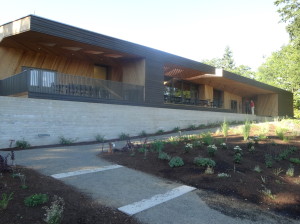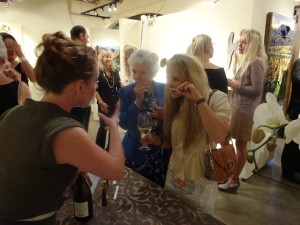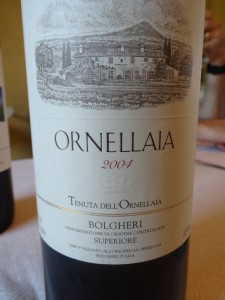
In the past quarter of the century, Tenuta dell’Ornellaia, an Italian winery in the Tuscan coastal town of Bolgheri, has become, or has achieved you might say, first growth or cult wine status since its first vintage in 1985. This year Ornellaia has been celebrating its 25 anniversary, the 2010 vintage, with events, auctions and special art created, all paying homage to a wine that’s as distinct as the vineyards it is grown in.
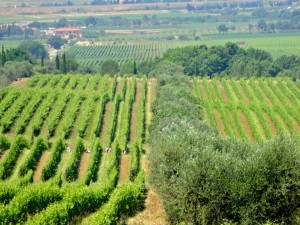
When most of us think of Tuscan wines, we think of Chianti and Chianti Classico, made from the Sangiovese grape. But nearly 50 years ago, some Italian winemakers and winery owners started thinking that there might be places in the country where the so called “international varieties” of Cabernet Sauvignon, Merlot, Petit Verdot and Cabernet Franc might do well and even thrive.
“It is a young region for wine,” says Riccardo Facco, Hospitality Director at Ornellaia. “Imagine Bolgheri 60 years 70 years ago was famous for potatoes and strawberries peaches.” He’s showing me the famous vineyards on the 198 hectare estate, planted to 100 hectares of Cabernet, Merlot, Cab Franc and Petit Verdot, with a little bit of Sauvignon Blanc, three hectares, thrown into the mix.
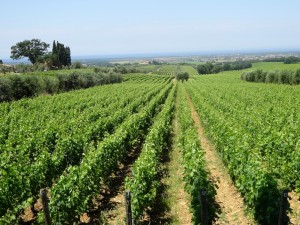
We are standing in the middle of the section of the estate called Bellaria. “It means beautiful breeze, the breeze from the sea takes away the humidity,” Riccardo says. The grapes from this 60 hectare plot go into the blend that is Ornellaia. It is a breathtaking view, looking over a gentle slope stretching almost to the sea. We definitely feel that wind, the wind that keeps the air moving through the vines and through the clusters, imparting a salinity to the wine that we would later taste.
The Bolgheri DOC, established in 1994 (almost 10 years after the first vintage of Ornellaia), first came to prominence thanks to another “super Tuscan,” as the Cabernet based blends of this region have been dubbed, called Sassicaia. Its international success brought other leading producers to the area, including Gaja. Ornellaia was founded in 1981 by the Antinori family, who later sold a share to Robert Mondavi of California’s Napa Valley. Mondavi then acquired full control of Ornellaia in 2002, transferring 50% to Marchesi de’Frescobaldi. The winery is now owned by the Frescobaldi wine family.
What helps make Bellaria special is that it is protected from cold winter winds coming from north thanks to a chain of hills separating the area from the rest of Tuscany, so the vines never freeze. It’s also a sunny area, and the southern and western vineyard exposure gives the grapes the sun they need to ripen well.
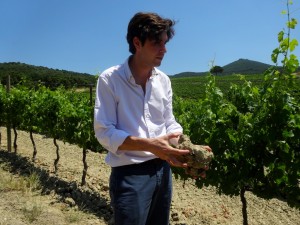
Within the 60 hectares of vineyard here there are are multiple blocks of different soils and microclimates, as many as 60 to 70 separate plots, each planted with a different grape variety, depending on how well that grapes thrives in the specific soil and climate. Ornellaia is meticulous in its viticulture methods, tailoring cultivation methods to each of the parcels. The goal is the truest expression of the land. To that end, instead of hiring seasonal workers for harvest, Ornellaia has its own year round crew. The philosophy is one I also encountered at other high quality wineries in Piemonte, something very different than what we see at many American wineries, where they contract out vineyard work and harvest to vineyard management companies. Ornellaia believes having their own crew is worth the investment, as they can train the workers to care for the vines throughout the year in a very specific year, with the knowledge retained harvest after harvest. There are also olives on the property, picked right after the grape harvest is over, something else keeping the crews busy.
Ornellaia may be the most famous wine but it’s not the only wine produced from this winery. There’s another 40 hectares, called the historical vineyards, the first ones to be planted on the estate. “Here you see the first parcel that was planted for Ornellaia, in the middle you can find vines that are 30-32 years old. In general the average age of vines for Ornellaia is 15 years old,” says Riccardo. This is also where we find the Masseto vineyard, home to the 100% Merlot called Masseto. This vineyard couldn’t be more different, in a much warmer part of the estate. It’s seven hectares, producing an average of 30,000 bottles a year (2,500 cases).

“Masseto means a little block of clay,” Riccardo tells me. Renown winemaker André Tchelistcheff (you’d call him a consultant these days) was working with Ornellaia at the time and decided this was the spot for Merlot on the estate. As with Ornellaia, all parcels are planted and farmed according to soil type and microclimate. Masseto is made of soil clay, with rock underneath, meaning the vines have a super struggle to find water and nutrients. The vines are terraced and I notice that you can kind of see the roots exposed on the vines.
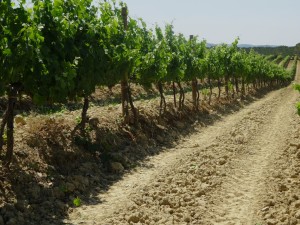
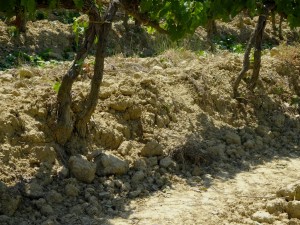
“The vines are not in the middle of the row, they are on the edge and this way the roots are able to keep the soil and then at the same time you see in the afternoon they will be exposed to the light of the sun. This pushes the vine to try to get down, for the roots escape from the hot try to find the refreshment.” The result is an intense, complex, multilayered wine, a Merlot like I’ve never ever had before. Mind blowing.
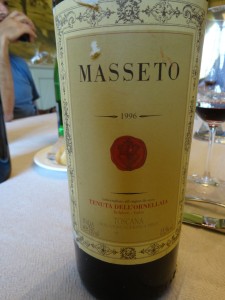
Knowing the obsessive attention to detail in the vineyard and in the winery explains the steep price tag on a bottle of Ornellaia and Masseto. All 60-70 blocks are harvested separately, fermented separately and age in barrel separately before being blended into the wine that will become Ornellaia or Masseto. Ornellaia is released 30 months after harvest; Masseto 36 months after harvest.
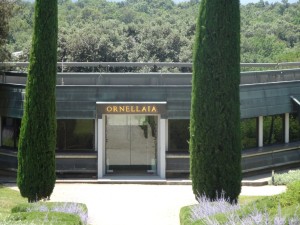
We’re in the winery now, a rather understated building, lying low on the horizon, where the art on display is commissioned by Ornellaia on a yearly basis, a program the winery calls Vendemmia D’Artista. For each vintage, one word to describe the vintage is chosen; this is the brief given to the artist for creating the artwork to celebrate the vintage.
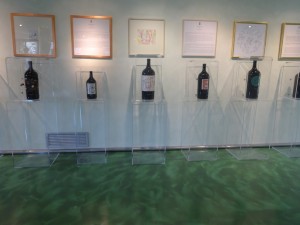
For the 25th anniversary vintage 2010 the word is celebration, and the artwork is not just on the bottles, it surrounds the bottles. I’ve never seen art done 3-dimensionally around a bottle like that. The shiny material is actually part glass, like a mirror but elastic metal and glass. Very very cool.
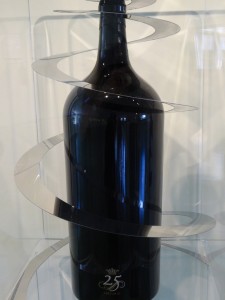
The real art however, is happening in the cellar. Here barrels full of the separate lot wines for Ornellaia age in oak, waiting to be blended. In the Masseto cellar, a key tool in the winemaker’s palate is proudly on display, a “T5” barrel made by the French cooper Taransaud. Consider it the Ferrari of wine barrels.
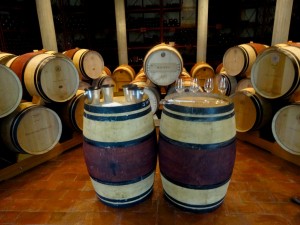
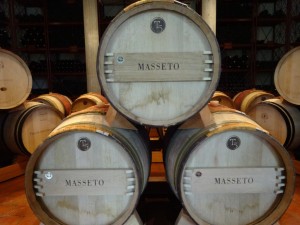
“For Masseto we use two kinds of barrels. the Seguin Moreau and the Taransaud,” says Leonardo Raspini, Ornellaia’s General Manager. “We have a little portion of the T5 to add the quality of barrel, the thickness the quality of the wood is really appreciable and for Masseto we prefer it to maintain a good quality for Seguin Moreau and the structure from Taransaud and to use the T5 to link the two.” It does a mighty fine job, as I taste the 2011 Masseto directly from the T5 barrel.
It’s extremely complex with lots of cherry fruit and herbal notes like licorice and even some floral, violet notes. Leonardo tells me 2011 is one of the beautiful vintages, perfect weather for Merlot, ” warm but not too much, dry but not too much. The 2011 represents Bolgheri character.” It has the structure of a Cabernet, but is rich with very soft tannins. It keeps me coming back for more. But it can also age and age very well. A little later we taste a 2006 Masseto which is stunning, with lively fruit, lots of herbal spice and a lush, velvety texture.
The 25th edition of Ornellaia, the 2010 vintage, was marked by a cooler vintage, which meant late ripening and the latest harvest for Ornellaia. The 2010 has the most percentage of Merlot in the blend, and is intense and aromatic yet retains that freshness that the wine is known for.
As it wraps up celebrations of its 25th anniversary, which continue through November, Ornellaia is getting ready to begin the 2013 harvest. In a few short years the winery has set the benchmark for making wines that are an honest reflection of the place, the vineyard and the specific piece of soil, where wine is created in the vineyard.

